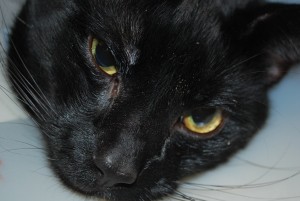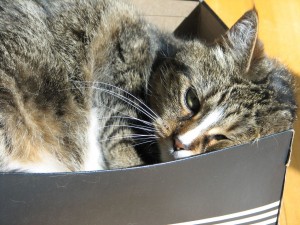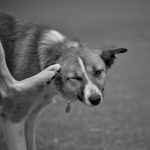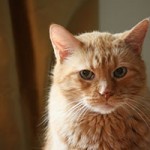The Fasting Cat
Many of us cat owners have heard that anytime a cat stops eating, alarm bells should go off…and, rightly so. Usually, a loss of appetite is almost always an indication your pet isn’t feeling well. Or it can be something as minor as the cat doesn’t like the new food you just bought.
It doesn’t take much to make a cat finicky. Cats only have 470 taste buds (compared to dogs that have 1700, and humans who have almost 10,000 taste buds). And, on top of that, cats don’t have a sweet taste bud. I wouldn’t be surprised if cats can barely taste its food. Basically, I’d say cats go by smell and texture, which probably explains why your cat may become finicky when you change the smell and texture of its familiar food (please see my article “Living With A Finicky Cat”).
Feline Hepatic Lipidosis
A major worry most pet owners have when their cat stops eating is something called Fatty Liver Disease, or Feline Hepatic Lipidosis (FHL). This is a condition that is caused by the accumulation of fat in the cells and tissue of the liver. When a cat starves, large amounts of fat that is stored in a cat’s body are released and travel through the bloodstream to the liver. The excess fat clogs the liver and leads to liver failure. If you do a Google search on FHL you’ll see statements like “if the cat goes without food for 24 hours the liver will shut down” or “a cat must eat every day.”
When I read statements like the ones above it makes me think of a few incidences where cats went without food for more than 24 hours and survived unharmed (or reasonably unharmed). For example, onetime I asked a good friend to feed my cat when I went away for a weekend. She lived next door and I had taken care of her cat on numerous occasions and I thought she could return the favor. My friend promised to look after my cat, and so, I went away. When I returned 4 days later, I discovered she had never fed my cat for 4 days! Fortunately, my cat was fine, which is more than I can say about my friendship with my so-called good friend (I’ve never been so pissed in my life).
But that’s a minor story compared to two cats named Ni Hao and Mee Mowee. Ni Hao was a 3-month-old kitten from Shanghai that became trapped inside a container aboard a ship and survived a two-week trip without food or water from China to Los Angeles (See Article). And Mee Mowee survived a 36-day trip from Virginia to Hawaii trapped inside a moving box (See Article). And there’s more stories of trapped hungry cats like Miss Pickford that survived a 3-week journey inside a container from Cyprus to the UK (See Article). If you read the articles, all the cats were dubbed “a miracle” and none of them suffered from anything more than dehydration, weakness, and weight loss. Nowhere was Hepatic Lipidosis mentioned. The veterinarians couldn’t give an explanation for their survival except to say, “they must have been in good health before the ordeal.”
I’m sure there are plenty of cats that did not survive such a long fast. Of course, we’ll never hear those stories. And, I have to say, I couldn’t find any follow-ups to the above stories to see if any of the cats suffered any lingering health problem after the stories were published. But I’d still like to know what it was about those cats was that helped them survive so long without food and water. Why didn’t they get Hepatic Lipidosis? Especially, if veterinarians insist a cat will become ill if they go without food for more than 24 hours.
Veterinarian Dr. Patricia Jordan and I once discussed the long fasting of these stowaway cats and we wondered if survival had something to do with their diet. Since most of these cats were strays then maybe they ate a prey diet of mice and not a high-carb commercial diet of kibbles. A kibble fed cat is more likely to be overweight than a raw fed cat. And it’s an overweight cat with all that extra fat that have a higher probability of developing Hepatic Lipidosis. Also, kibbles are low in water content and that will make the cat more dehydrated. Starchy food like kibbles is much harder to digest and that can allow more toxins to accumulate in the bowels. Maybe this is a hint. But without data on the typical diet of a stowaway cat, it is hard to say.
FHL In The Wild?
Big Cats in the wild don’t eat every day. A tiger may consume one animal a week. A lion may gorge itself on 88 pounds of food in one feeding and then not eat for a few days. Wildlife biologists say that for every 5 attempts a lion hunts and kills a prey, the lion is successful only once. In a year, one lion may consume the equivalent of 30 medium sized prey animals or 10 to 20 large prey animals. That’s a total of 50 meals a year. (Do Big Cats eat small prey? Yes, they do. But it’s not exactly a nutrient dense or high enough in calories to maintain a 175-pound to 600-pound cat).
I tried to find information on whether Big Cats in the wild get Hepatic Lipidosis and I found one study discussing liver disease in wild felines: Article. Its conclusion was that liver disease is rare in undomesticated felines (The Big Cats in this study were all zoo animals. So, basically, the felines’ diet and environment were under human control and not in a natural surrounding. Although these cats were fed an all-meat diet, it’s unknown how close the diet imitated a true wild diet).
Fasting A Cat
Not too long ago I took a class on natural treatments for IBD in cats. At one point, a Food Sensitivity Elimination Trial was suggested to evaluate whether the cat has a sensitivity to a particular protein source (65% of IBD in cats is due to food sensitivity). It was mentioned to fast the cat on bone broth for 3 days in between food testing. It’s not the first time I’ve heard holistic/naturopathic veterinarians talk about fasting a cat.
However, in spite of the obvious clinical symptoms of anorexia, muscle wasting, and weight loss that is often associated with Feline Hepatic Lipidosis, the cause of this condition is not fully understood. Science does not understand the exact metabolic changes that are responsible for the rapid accumulation of fat in the liver.
In cats, fat accumulates in the liver during fasting, leading to a fatty liver syndrome or feline hepatic lipidosis (FHL). Blanchard et al. (2002) completed a study to determine whether a L-carnitine supplement could protect fasting cats from ketosis and, therefore, whether a L-carnitine supplement would improve carnitine and lipid metabolism in FHL. The results demonstrated the protective effect of a dietary L-carnitine level in cats with a high risk of obesity.
I hesitate to ever fast a cat. But, on the other hand, I’m curious about the stowaway cats and how they were able to avoid hepatic lipidosis.
How Is Feline Hepatic Lipdosis Disease Treated?
Treatment will involve liver support and nutritional support. Feeding tubes are hooked up to the cat to deliever nutrients and calories. Soild food should be introduced once a day to get the cat interested in eating again. And as soon as the cat is able to eat on its own, feeding tubes are slowly reduced and solid food is increased. It’s important the procedure is done slowly. A sudden consumption of food after a long period of fasting or starvation can create life-threatening imbalance of electrolytes in the blood.
In addition, the cat will need subcutaneous injection, or sub-q, to rehydrate the body. Potassium and phosphate supplements are often added to the sub-q fluids to help rebalance electrolytes.
Vitamin B-12 deficiency is common in FHL cats. So, B-12 shots may be necessary, as well as, magnesium supplements. Magnesium is needed for muscle repair, blood sugar regulation, heart health, and for making protein in the body.
To slow down liver damage, you may want to give the cat S-adenosyl-L-methionine (SAMe), dandelion root, and don’t forget Milk Thistle to help remove toxins from the liver.











